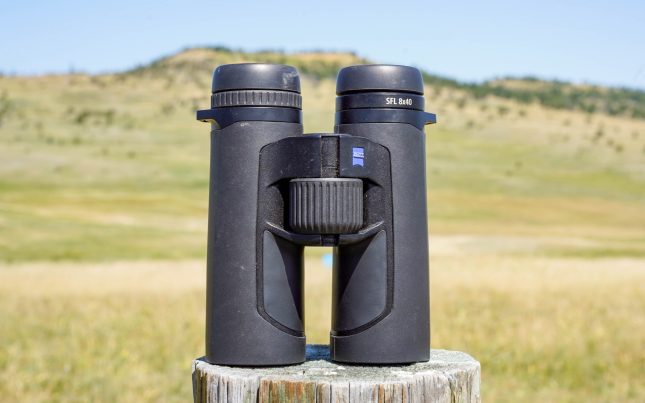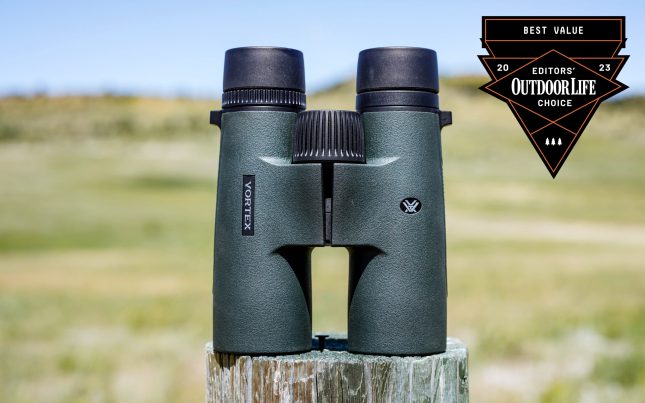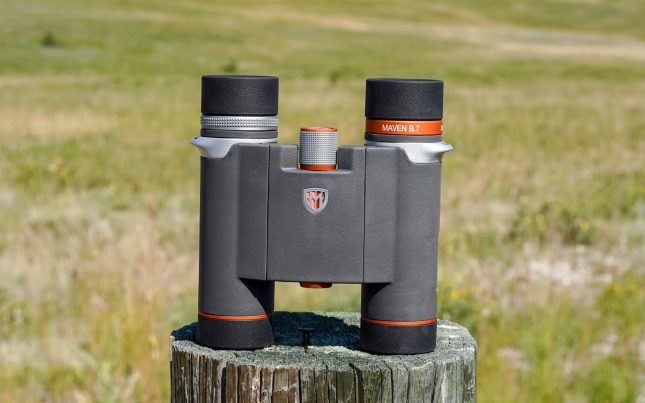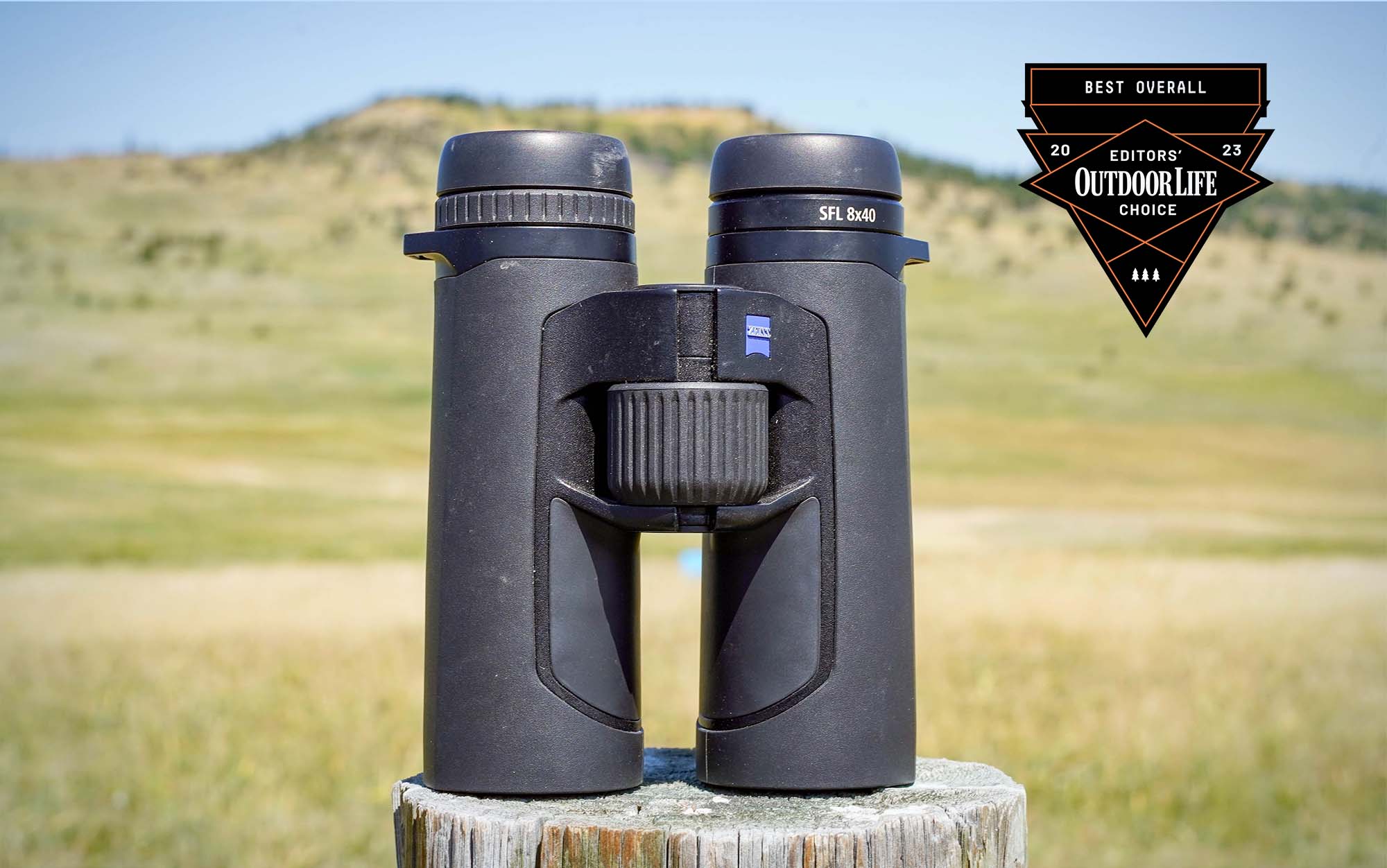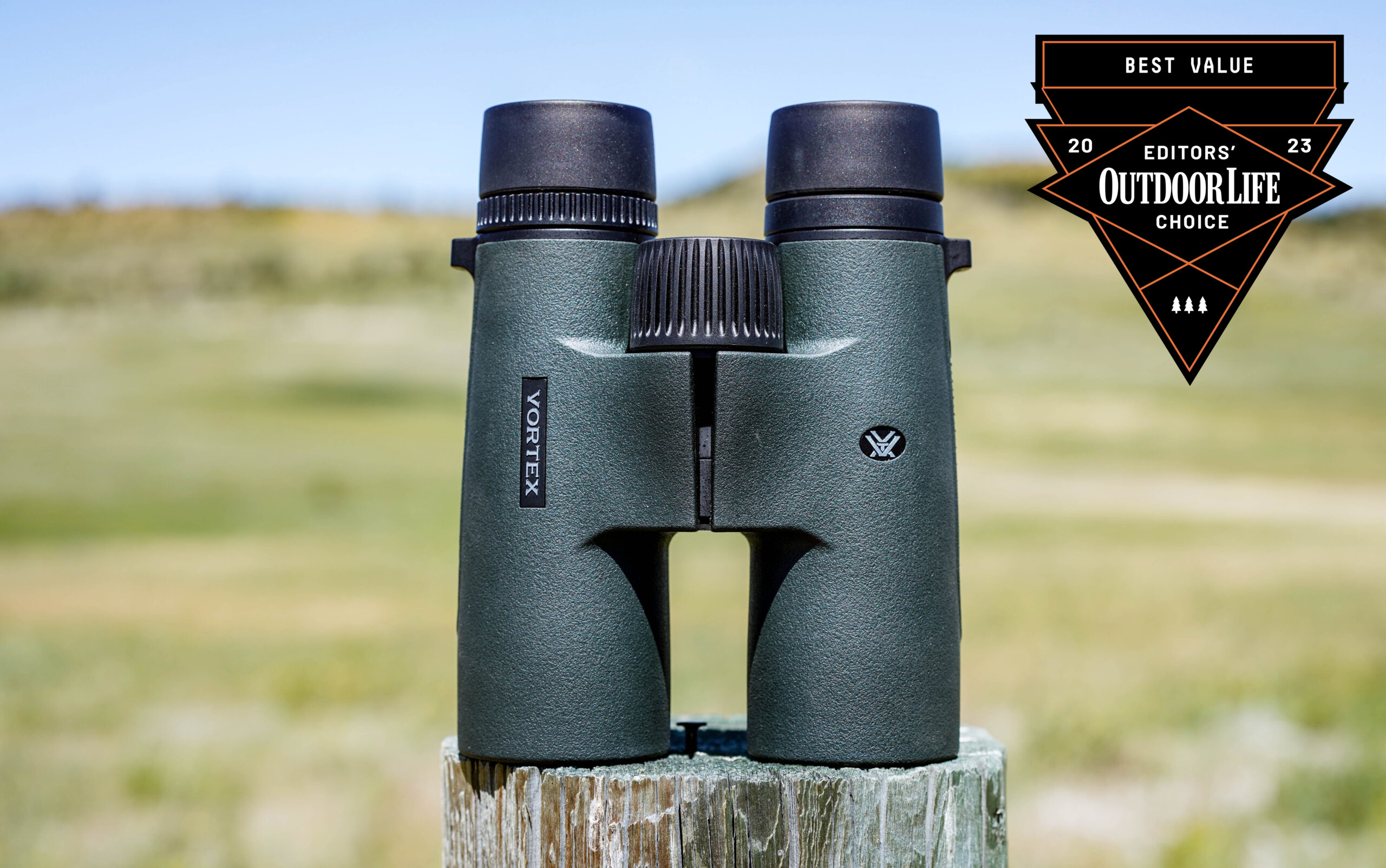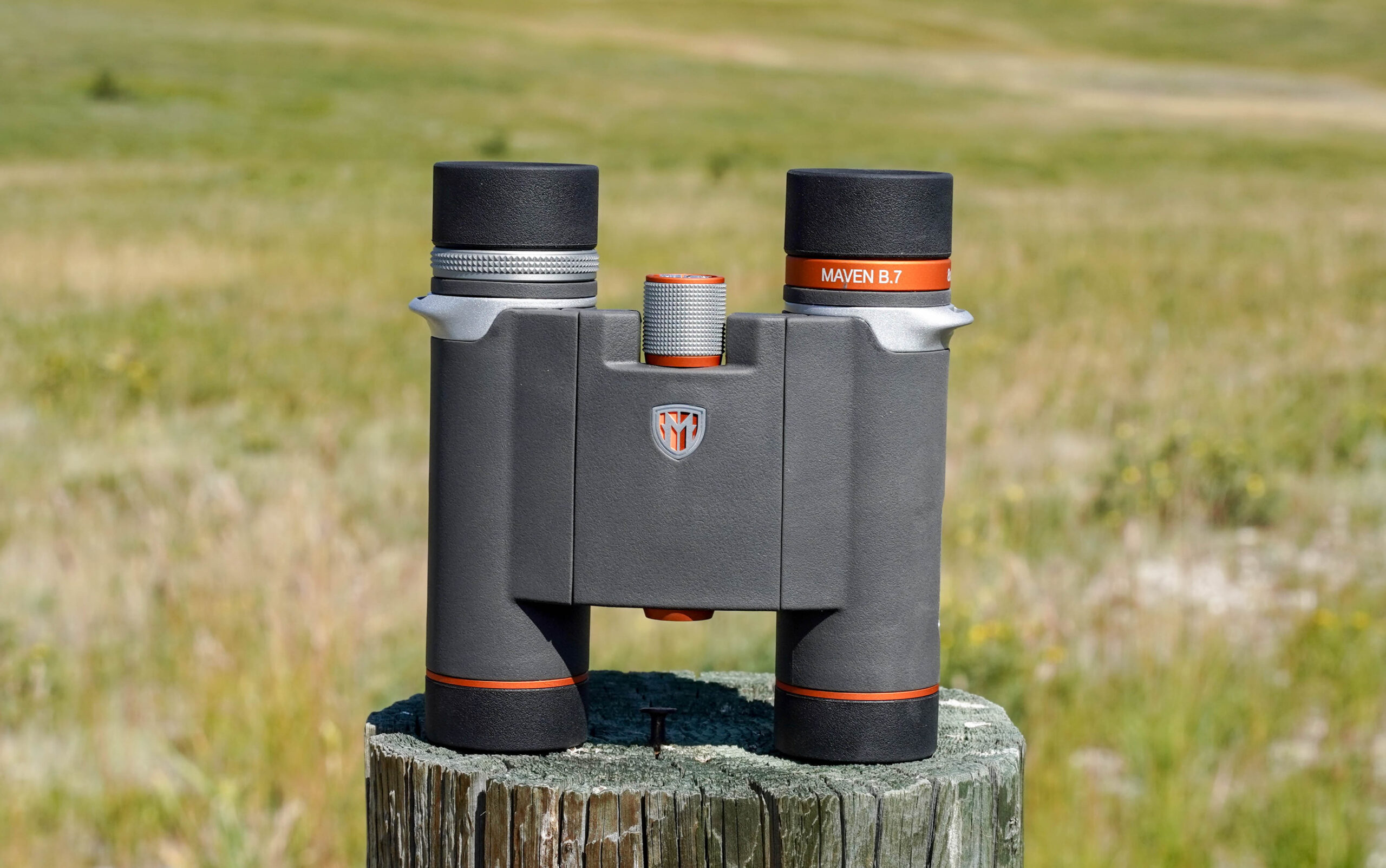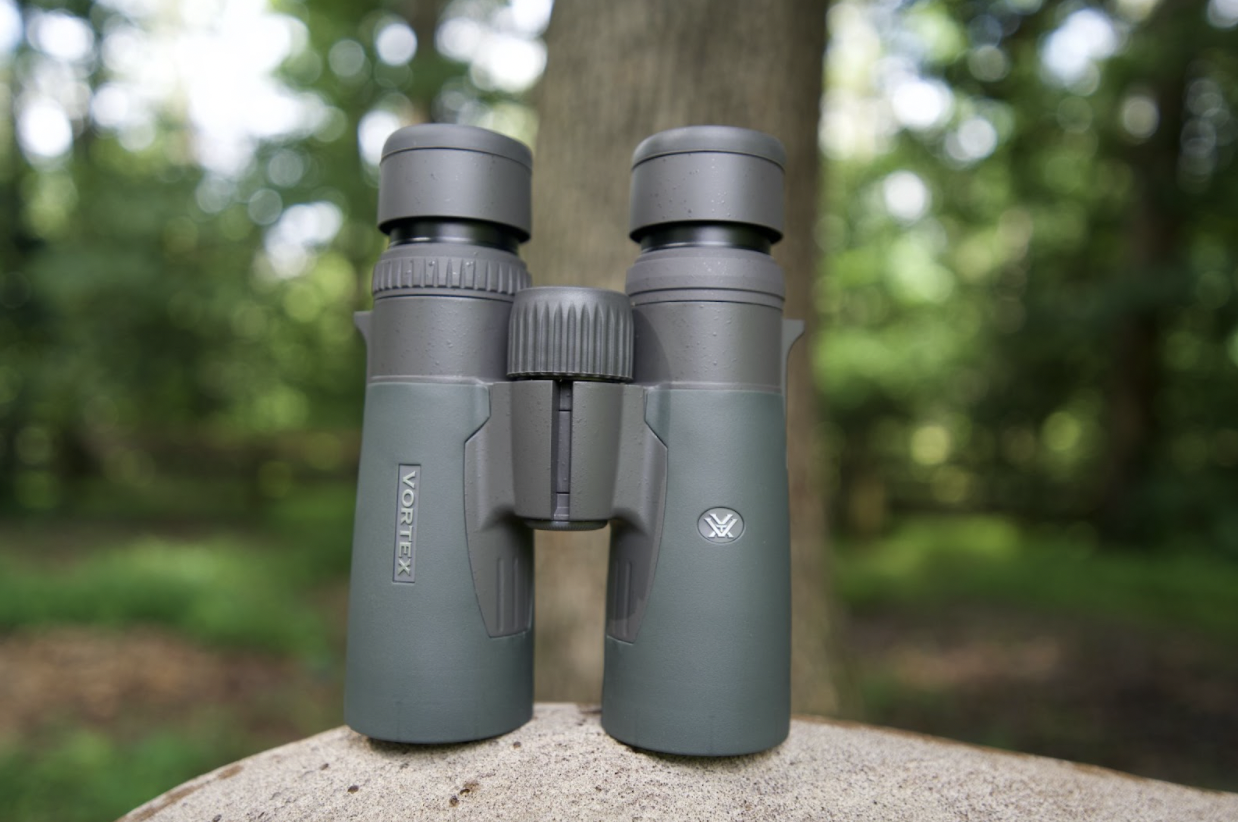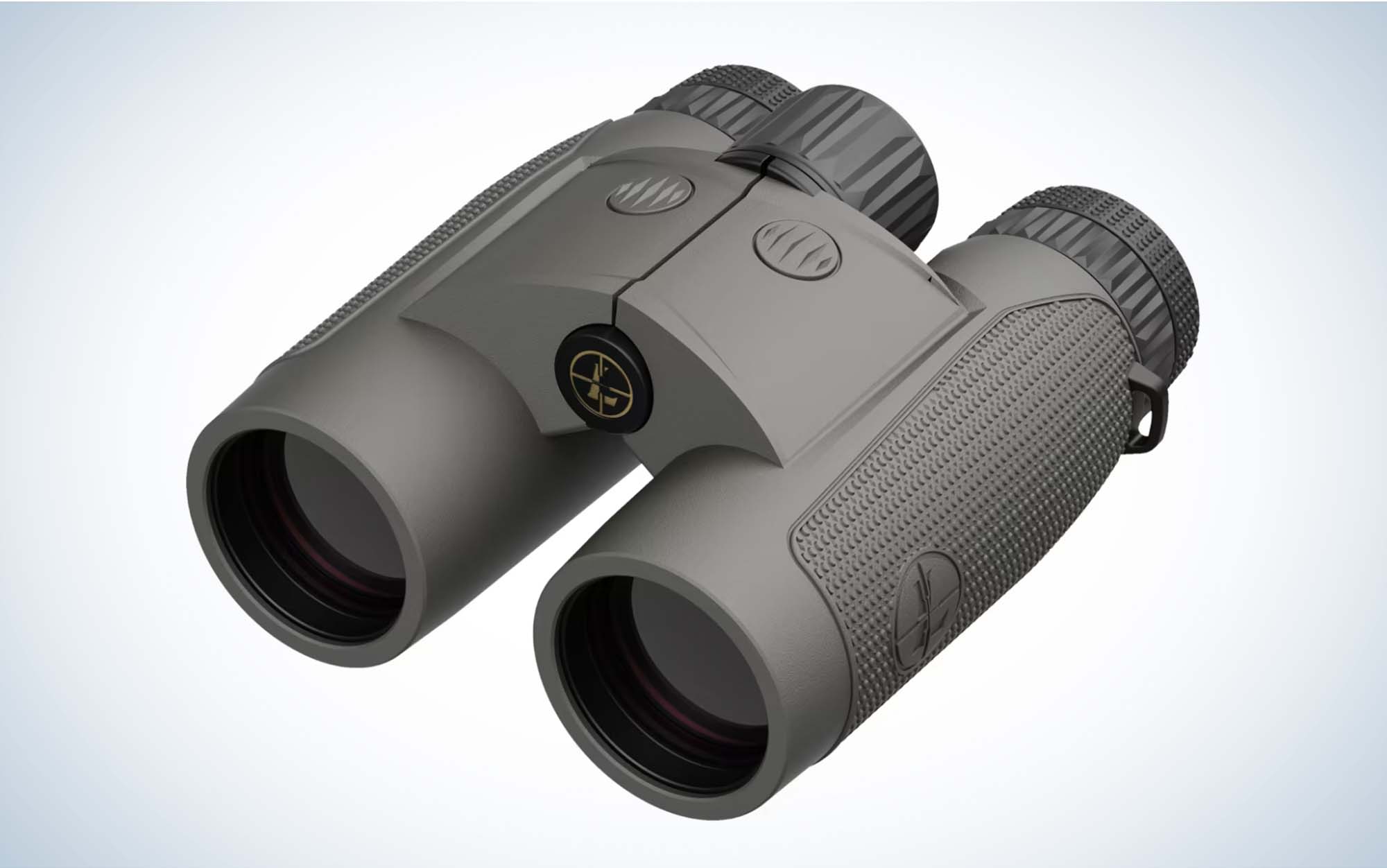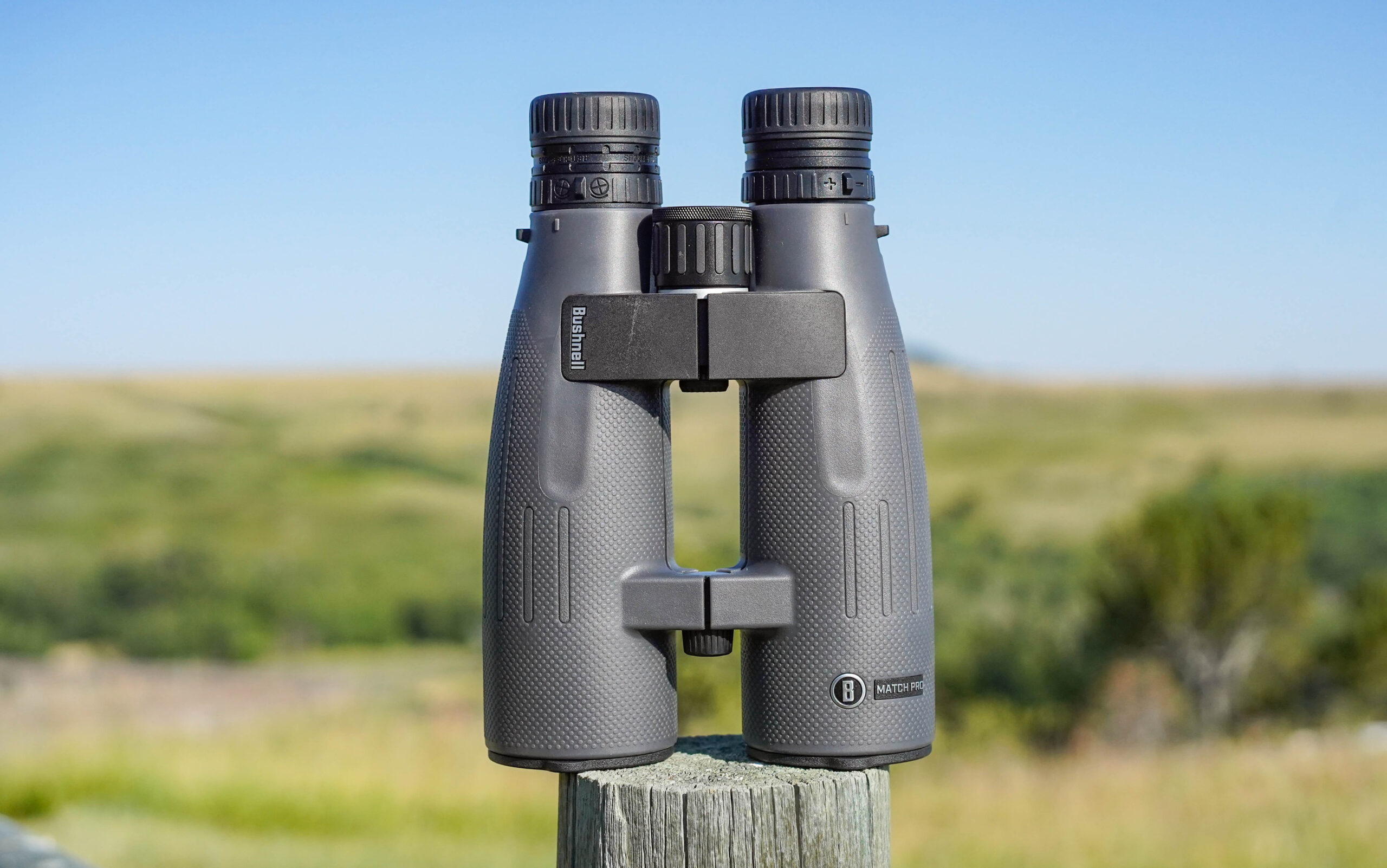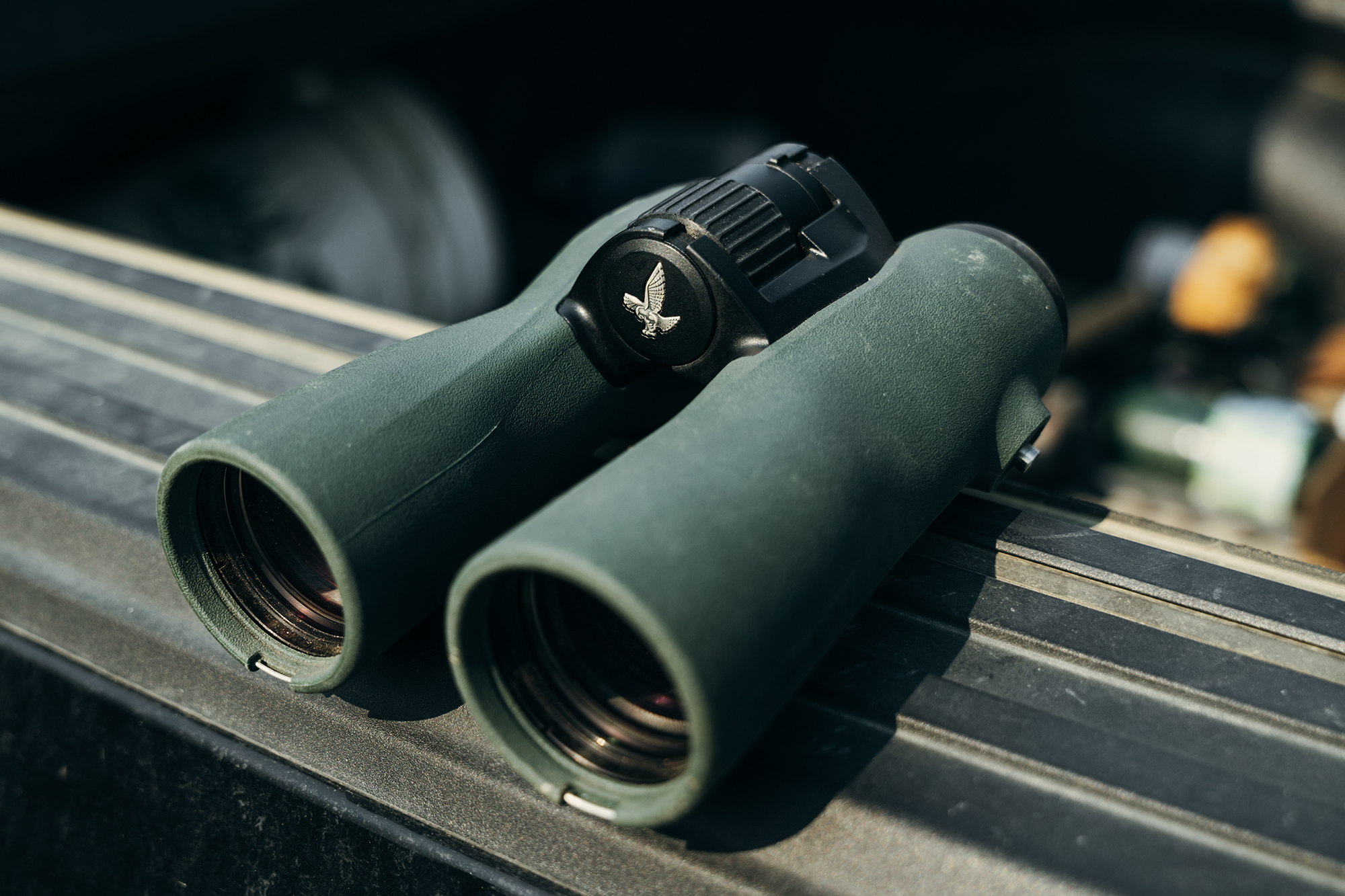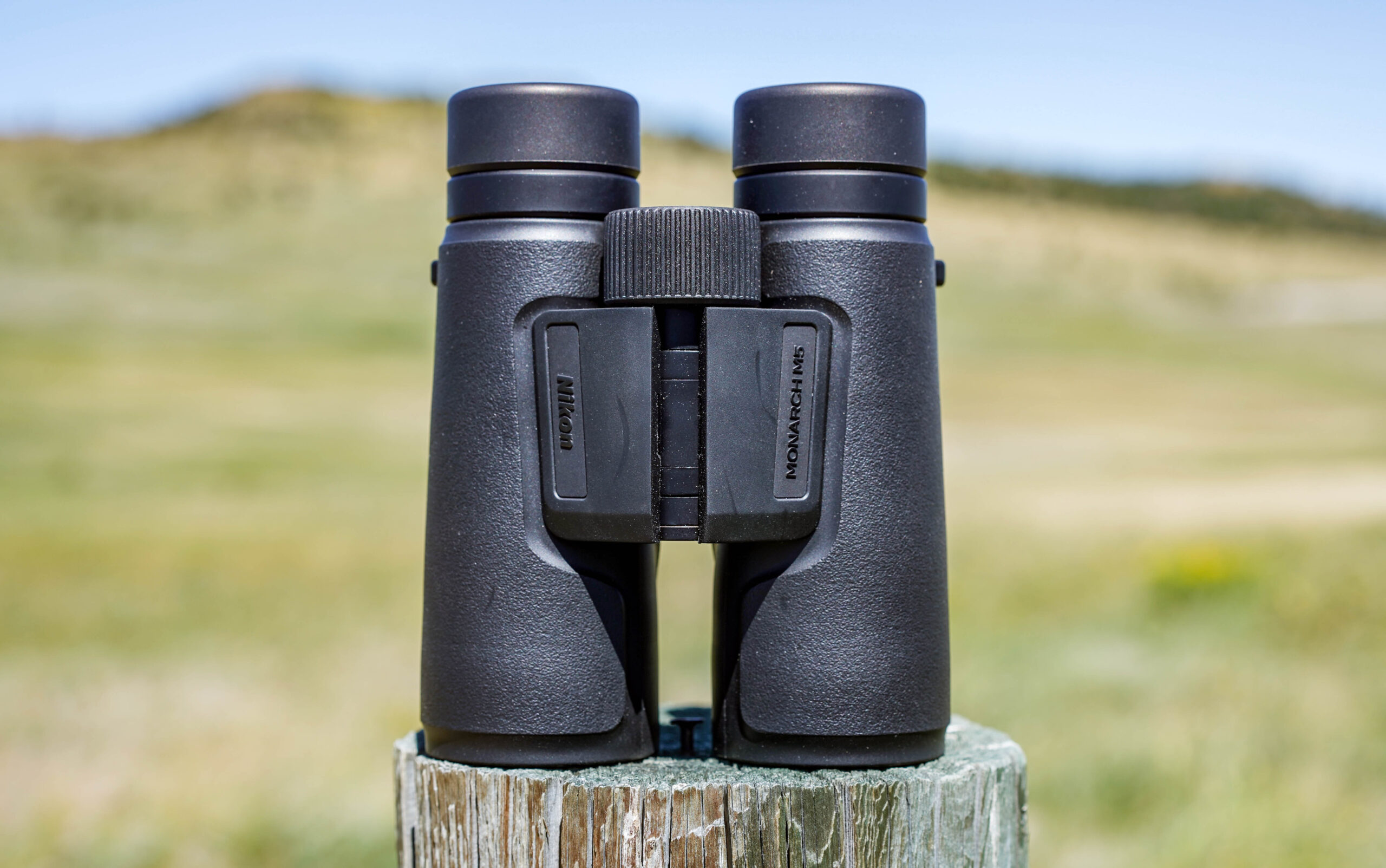We may earn revenue from the products available on this page and participate in affiliate programs. Learn More ›
More reliable than a rifle and more portable than a pack, a binocular is as essential to a hunter as their boots or gutting knife. Even a crappy binocular will shrink distance, bringing far-away objects closer. But the best models will enlarge your world, helping you find animals, identify approach routes, and bathe your surroundings in vibrant high resolution.
More practically, a good binocular will save you miles of walking by glassing prospective areas. I’ve used the light-amplifying capabilities of binoculars to find my distant (and temporarily lost) pickup long after sunset.
While binoculars share many attributes — parallel magnified tubes governed by a common focus control — they are much more different than their generic appearance might suggest. Do you prioritize magnification or field of view? Do you want a durable closed-bridge bino, or a more fragile open-barreled design? Do you need an integrated laser rangefinder, or is low-light capability more important to you?
This review will help you answer those questions in order to find the best hunting binocular for your specific combination of terrain, game species, hunting style, and budget.
- Best Overall: Zeiss SFL 8×40
- Best Value: Vortex Triumph HD 10×42
- Best for Bowhunting: Maven B.7 8×24
- Best for Western Hunting: Vortex Razor HD 10×42
- Best Rangefinding Binocular: Leupold BX-4 Range 10×42
- Best for Precision Shooting: Bushnell Match Pro ED 15×56
- Best Ballistic Rangefinding Binocular: Leica Geovid Pro 42
- Best Premium Binocular: Swarovski NL Pure
- Nikon Monarch M5 8×42
How We Tested the Best Binoculars for Hunting
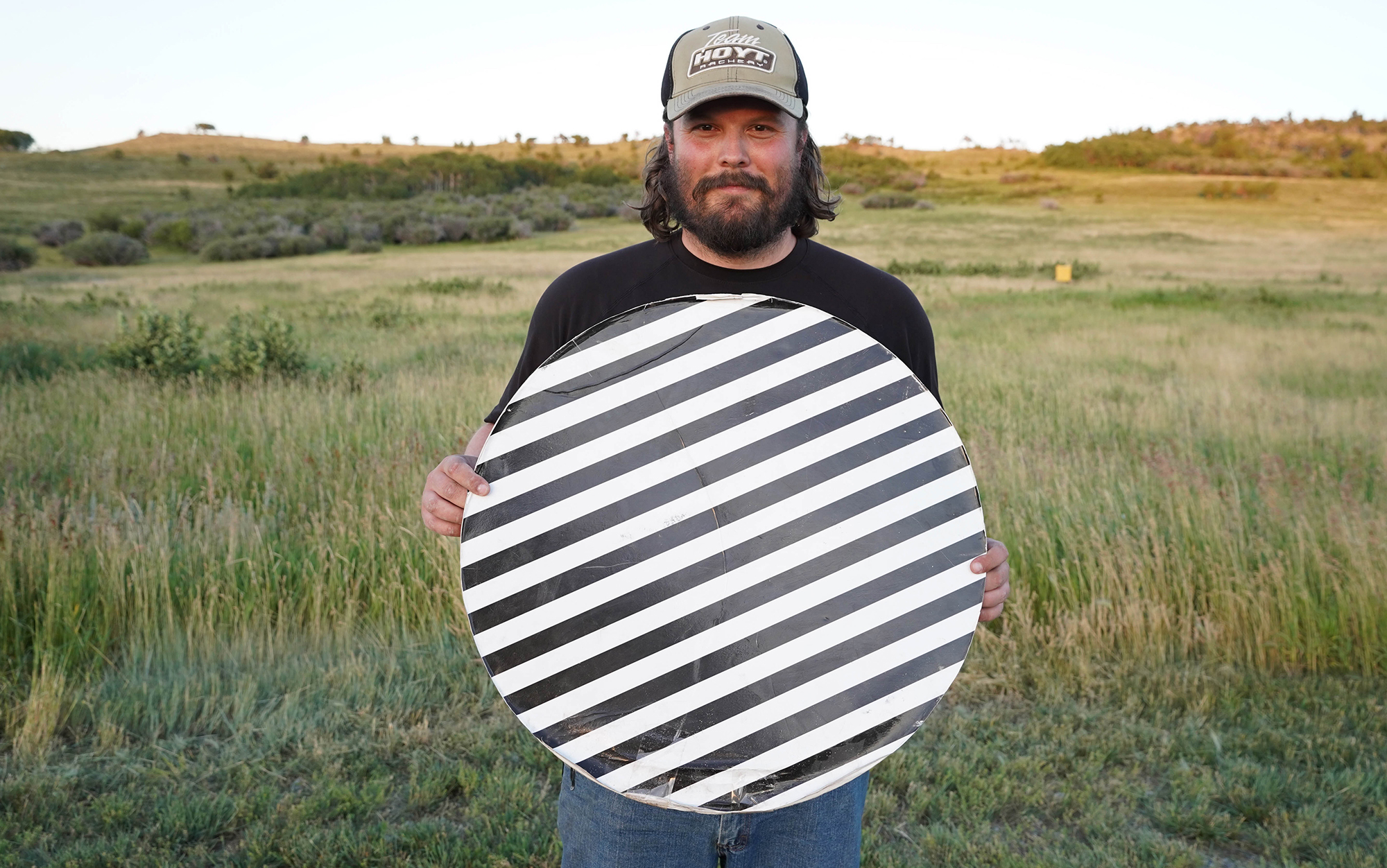
We put all submissions through the same criteria. First, we measure optical resolution using the diminishing black-and-white lines of a 1951 Air Force Resolution Target to score the optical performance of each submission. We also measure the low-light performance of each binocular by mounting them to tripods and focusing them as a group at 200 yards at a black-and-white resolution target at twilight. This is an important consideration for hunters since game animals move more in the early morning and late evening than at any other time.
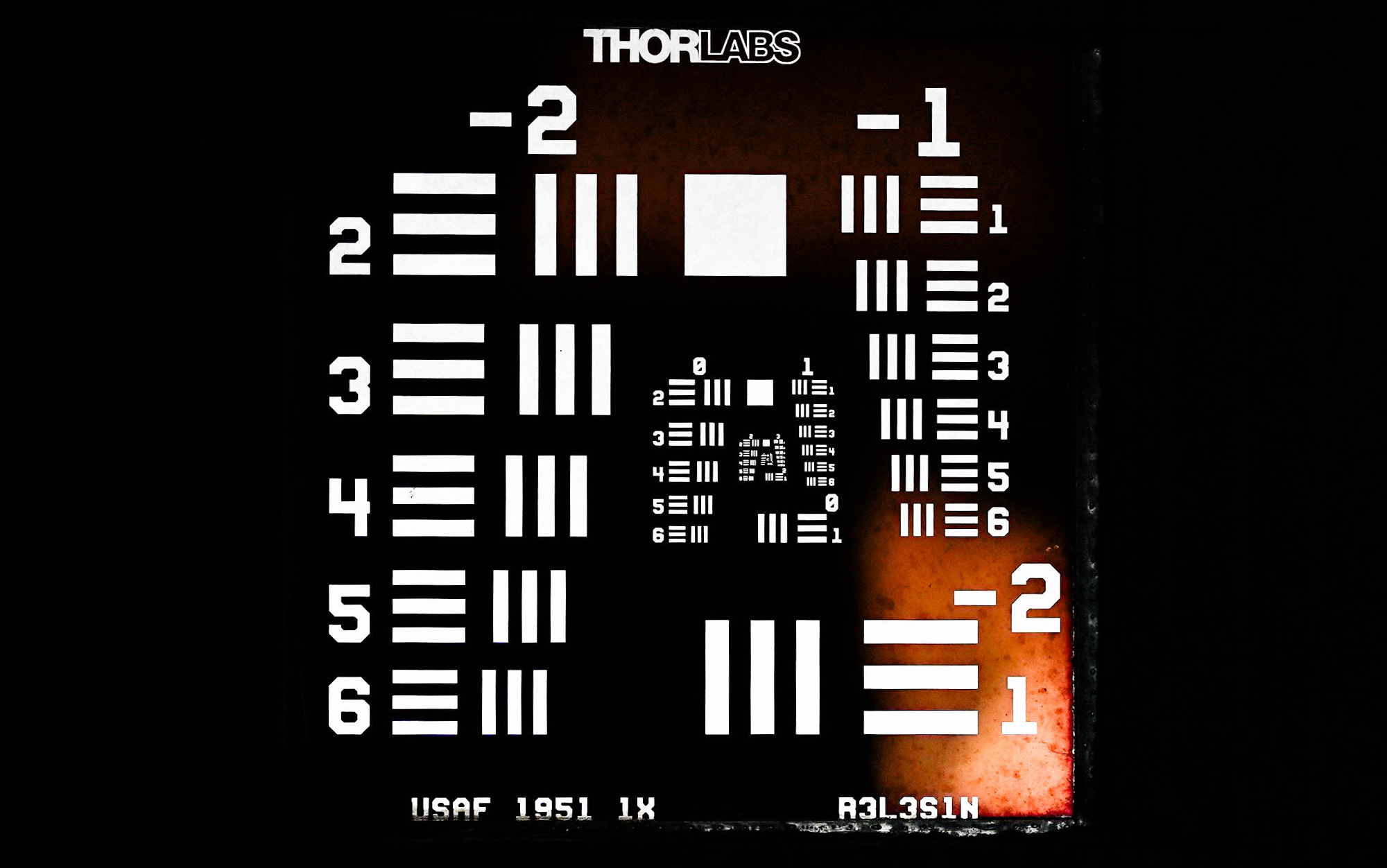
The binocular that can “see” the longest into the gathering darkness gets top marks. The model that loses its night-vision earliest gets the lowest score. Binoculars in the middle receive weighted scores somewhere between those two poles. We averaged the results over three nights to arrive at our adjusted score.
How We Score and Grade Hunting Binoculars
We break our 10-point scoring into four general categories: optical performance, mechanical performance, design, and value. The average of these categories is the basis of our grades, detailed below.
Optical performance includes the resolution and low-light tests plus the more subjective assessments of image quality and brightness. Mechanical performance assesses the durability of the submission along with its controls: focus and diopter controls, eyecup extension, and comfort. In the case of rangefinding binoculars, it also factors the electronic interface and performance. Design considers the exterior finish, interior blacking, tripod mount, innovation, versatility, and comfort. We ask testers to evaluate this critical question: how long could you glass with this binocular?
And then our price/value score rates how much optic—along with warranty and amenities such as carrying case or harness—you get for your money. The binocular that gets the highest overall score wins our Editor’s Choice Best Overall award for the best in the category; the optic with the highest price/value score wins our Best Value recognition.
For some members of this roundup of hunting binoculars, we are using test results from previous years (2022 bino test), but we tested most of these entries in our 2023 optics test.
Grading Hunting Binoculars
Our 10-point evaluation adds up to a total numeric score, but we translate those to grades for each submission. Our Optical Performance grade combines the resolution, low-light, image, and brightness scores. Our Mechanical Performance grade aggregates the mechanics and durability score. The Design grade considers construction, innovation, versatility, and comfort. And then the Price/Value grade is our value grade.
To earn an “Excellent” grade, the average of that category must be 9 or higher, which is extremely hard to achieve. “Very Good” is an average score of 7 to 9. A “Good” grade is 5 to 7. Our “Fair” grade is 3 to 5, and “Poor” is anything under 3.
Best Binoculars for Hunting: Reviews and Recommendations
Best Overall: Zeiss SFL 8×40
Score Card
- Optical Performance: Very Good
- Mechanical Performance: Excellent
- Design: Excellent
- Price/Value: Very Good
Key Features
- Double-hinge, open-barrel design
- Right-barrel diopter control
- Oversized focus wheel
- Extremely light weight
- Also available in 10×40, 8×30, and 10×30 models
Pros
- SmartFocus wheel zooms from close focus to infinity in 1.4 turns
- DoubleLink Bridge enables good barrel grip
- Premium glass and coatings
- 4.9-foot close focus
- 22.6 ounces
Cons
- At $1,500, fairly pricey binocular
- Straps and case are fairly pedestrian
The world of premium binoculars apparently has no upper limit. You’ll pay over $3,000 for Swarovski’s excellent NL Pure or for Leica’s stunning Noctovid. Zeiss, too, asks $3,000 for its marvelous Victory SF binocular. So to find a binocular that performs nearly on par with those flagship models for half the price is worth talking about.
Zeiss saves some money on its SFL model by importing it from Japan; most premium optics are made in Germany or Portugal. And Zeiss found some additional savings in glass by using thinner lenses than it uses in its SF line. Those thinner lenses also allow the SFL to shave nearly a half pound from the SF in the same configuration.
But the image delivered by those halfling lenses is every bit as sharp and vibrant as those of Zeiss’s other premium binoculars. The SFL easily posted the top resolution score at this year’s optics test, and testers raved about the vibrant image with rich contrast and stunning colors. It lost points on disappointing low-light performance, which was partly due to its diminutive 8×40 configuration.
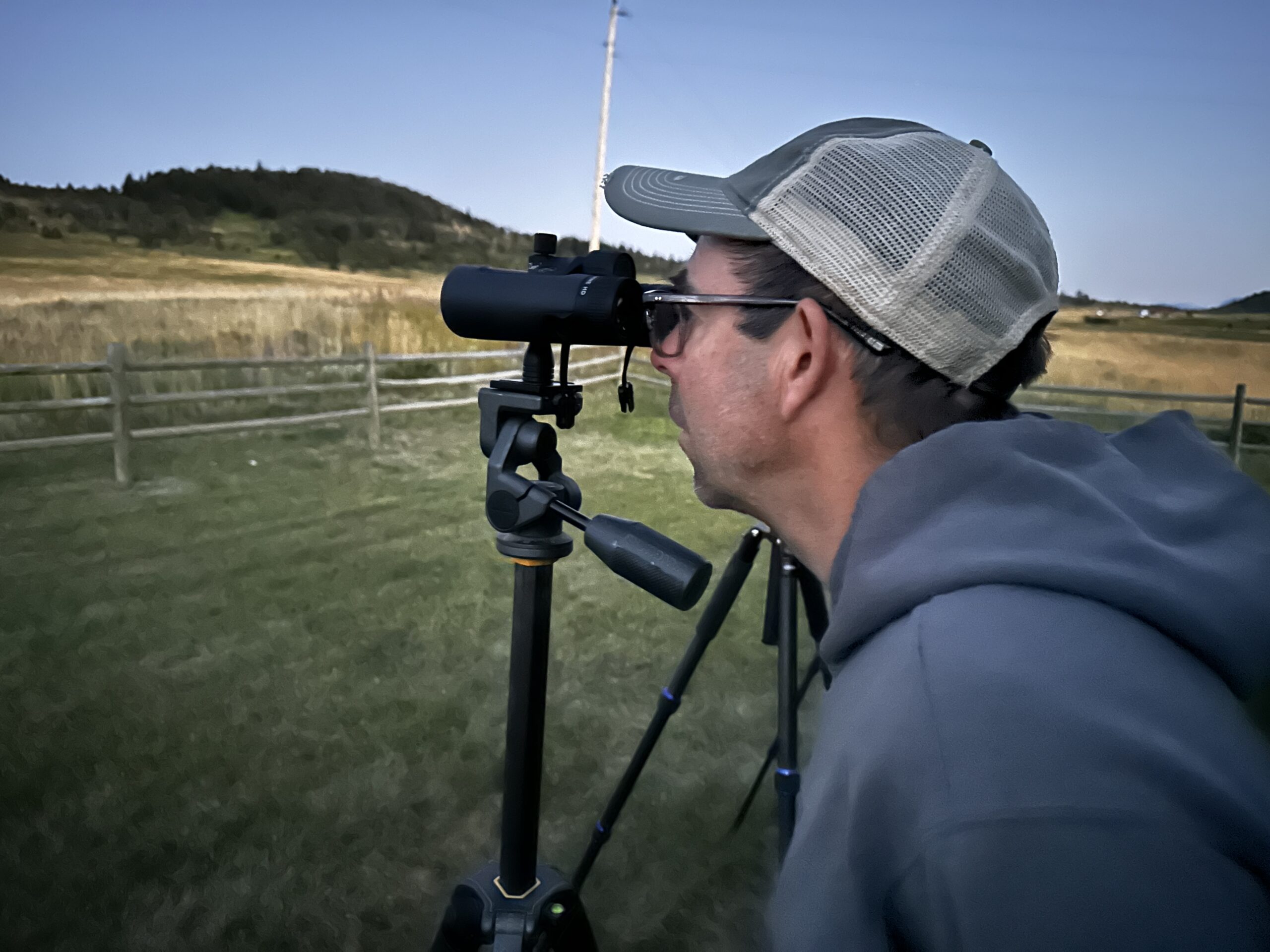
But the reason the SFL is here in the top spot as a hunting binocular is its field-worthy operation. Its oversized focus wheel riffs from an extremely tight close focus of 4.9 feet out to infinity in just 1.4 rotations of the wheel. That’s a huge asset for brush hunters, who use their optics to pick apart various distances, and for Western hunters, who might pan from middle-distance cover out to far vistas in the same field of view. The focus wheel, it should be noted, moves as though it rides on ball-bearing tracks, so smooth and fluid.
The Zeiss’s name stands for SmartFocus Lightweight, and the 1.5-pound heft makes them the lightest premium binos on the market, and a wonderful companion for long hikes over difficult terrain. The balance and grip provided by the open-bridge design makes the SFL feel even lighter, and testers gave high praise for the binocular’s tapered eyecups that were extremely comfortable to use for extended periods.
That’s the real question to ask of a hunting binocular—how long do you want to spend behind it? The more and longer you use a binocular, the more game you’ll spot and the more successful you’ll be. Few other pieces of hunting gear have that outsized effect on your outcome. If the 8×40 isn’t for you, look to the SFL in 10×40, 8×30, and 10×30.
Since the test, we have kept reaching for the Zeiss any time we required a binocular, one of the surest signs that it’s an optic worth a look. And possession.
Best Value: Vortex Triumph HD 10×42
Score Card
- Optical Performance: Fair
- Mechanical Performance: Good
- Design: Good
- Price/Value: Very Good
Key Features
- Single-hinge, closed-bridge design
- Roof-prism design
- Right-barrel diopter control
- Fully transferable lifetime warranty
- Tripod adaptable
Pros
- Ships with excellent GlassPak harness
- 22.9 ounces
- Extremely accessible real-world street price of under $100
Cons
- Significant peripheral distortion
- Flimsy feeling
How on earth can Vortex bring a capable binocular to the masses for under $100? With a good bino harness and the brand’s legendary warranty? Those were questions our test team batted around as we handled this new entry-level binocular. Then we got behind the lenses and learned some of the answers.
The biggest answer is the class of glass inside the new Triumph HD is cheap. The Vortex received uniformly downbeat assessments in optical performance; it scored near the bottom in low-light brightness, and its resolution score was just below the median. Testers further complained about blue color fringing, noticeable edge distortion, and blurry focus.
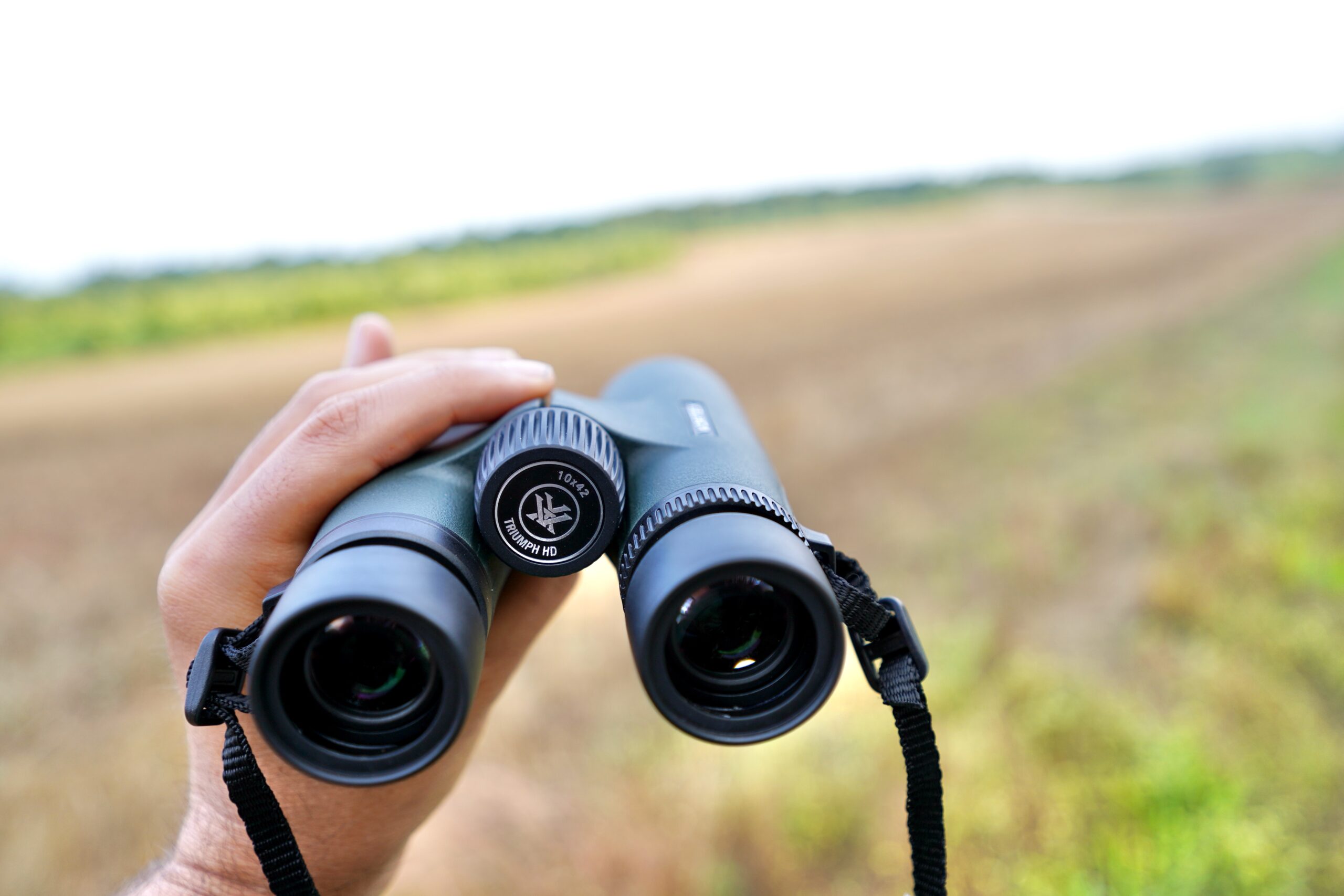
But we also recognized that you shouldn’t expect world-beating glass inside a $99 binocular, and that same realism pervaded our assessment of the Triumph’s mechanical performance. The diopter adjustment is stickier than we’d like, and the overall build feels flimsy. But the tapered eyecups move with positivity and the focus wheel is tight and responsive. The texturing, balance, and overall design is better than we’d expect for the price.
On the value side of the ledger, the GlassPak case and integrated harness confirms the Best Value designation we gave the Triumph HD. This would make a very good first optic for a hunter, birder, or shooter, and if treated gently is a good choice to throw in a pickup or cabin. We’re not sure how much rough handling this bino can take, but Vortex’s excellent warranty and customer service is a cheering consolation.
Read Best Binoculars for the Money to see more high-value binoculars.
Best for Bowhunting: Maven B.7 8×24
Score Card
- Optical Performance: Good
- Mechanical Performance: Very Good
- Design: Very Good
- Price/Value: Good
Key Features
- Double-hinge, closed-bridge design
- Right-barrel diopter control
- Extra-low-dispersion glass
- Extremely compact design
- Also available in 10×24
Pros
- Weighs just 12.4 ounces
- Highly textured focus and diopter controls
- Excellent treestand or turkey-vest optic
- Distinctive orange accents
Cons
- Too small for open-country glassing
- Controls hard to manipulate with gloves
With this petite binocular, introduced earlier this year, Maven is well on its way to filling out its product line. The B.7 is a compact version of the direct-to-consumer company’s excellent B.3 line.
It should be said at the outset that this is a fairly specialized optic. It’s configured for portability and use in tight quarters and in close ranges. Think whitetail hunting out of a treestand or ground blind. Or turkey hunting just about anywhere. I use sub-compact binoculars when upland hunting, tucked in a pocket of my bird vest, to positively identify distant birds, find my dog, or confirm a distant point.
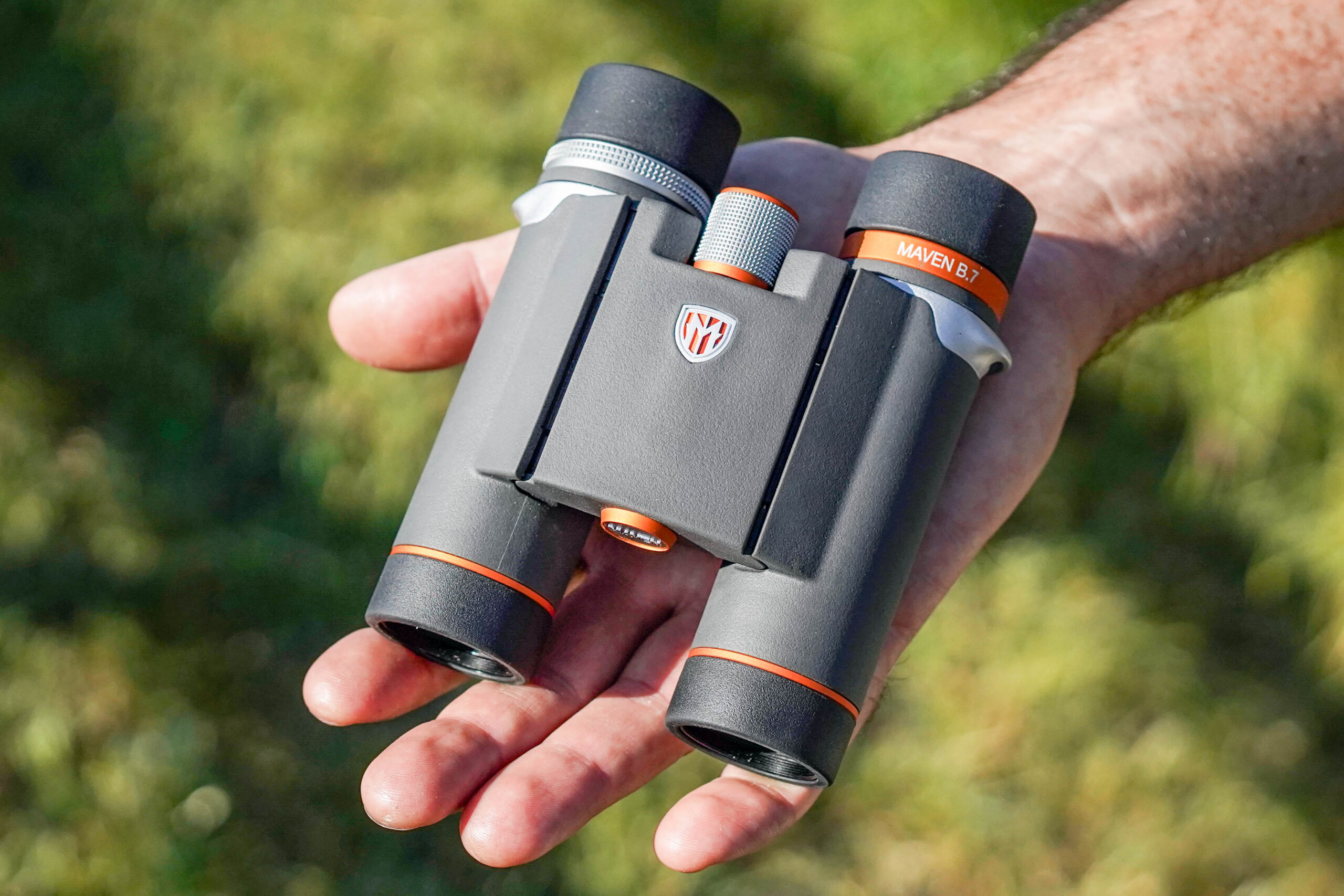
The Maven is one of the best-rendered versions of this class of binocular. The double-hinge design allows the barrels to nest under the bridge and fit inside a roomy shirt pocket. The glass is surprisingly good for this mini optic. Maven uses extra-low-dispersion glass that reduces glare and boosts colors and contrast of images, which helped the B.7 post one of the best resolution scores of our 2023 binocular class. But the ED glass is also responsible for the fairly steep price; the 8-power B.7 retails for $600; the 10-power version sells for $625.
Outdoor Life’s optics test team gave the binocular good price/value scores, and they praised the solid build and responsive controls. But several testers noted the limitations of the platform.
“This would be a good spot-and-stalk bino for those times when I don’t want to carry a pack or even a binocular harness,” said tester Ky Idler. Tester Dale Manning further noted that the B.7 would “make a great optic for sporting events, turkey hunting, deep-woods treestand hunting, but for me it’s too small to be a go-to field bino.”
Fair enough, but for those hunters looking for a combination of outsized optical performance in a very trim package, this binocular fits just about anywhere.
Read our Maven B.6 review to learn about Maven’s full-size option.
Best for Western Hunting: Vortex Razor HD 10×42
Score Card
- Optical Performance: Very Good
- Mechanical Performance: Very Good
- Design: Very Good
- Price/Value: Good
Key Features
- Single-hinge, open-barrel design
- Right-barrel diopter control
- Oversized focus wheel
- Oversized eyecups
- Also available in 12×50, 8×42, and 10×50 models
Pros
- Nicely balanced
- Excellent class of glass
- One-hand operation
- Excellent warranty and customer service
- Ships with binocular harness
Cons
- At about $1,200, a fairly pricey binocular
- Barrels can become slick
The best thing that can be said about a binocular is that it makes the world appear larger than it is, by delivering to the eye an image that’s bright, colorful, and vibrant. The Razor HD does all that, but what’s more important for hunters is that it does it with a wonderfully useful design that is easy to use with one hand.
The grippy open-barrel design can easily deploy with a single hand, but what makes the Vortex especially responsive is its highly textured, ergonomic focus wheel, which is an easy reach for a fingertip. That’s a valuable asset for bowhunters or any hunter whose other hand is carrying a carbine, crossbow, or other hunting implement. The Razor HD further endears itself with its extremely large and accommodating eyecups and eyepieces, which are not only comfortable against your brow but which enable extended glassing sessions.
The Razor HD is the best example we’ve seen of what the industry calls HD, or high-definition, glass. That’s a relatively meaningless term, but the glass that powers the Razor HD is on another level from most HD or UHD glass. Vortex claims to index-match the lenses in order to balance their performance, and the coatings further boost color fidelity and contrast.
With a price tag well over $1,000, this is a serious investment, but Vortex softens the hit by including a premium GlassPak binocular case and harness with the Razor HD. And the company’s legendary no-questions-asked warranty further makes the case for the Vortex not only as a hearty companion in the hunting field, but as a good investment.
Read our full Vortex Razor HD binocular review to learn more.
Best Rangefinding Binocular: Leupold BX-4 Range 10×42
Score Card
- Optical Performance: Good
- Mechanical Performance: Very Good
- Design: Good
- Price/Value: Very Good
Key Features
- Laser rangefinding binocular
- Ambidextrous ranging button
- 2,600-yard ranging capability
- Uses Leupold’s wind and ranging engines
- 12-yard minimum range
Pros
- Tripod adaptable
- Fast laser processor
- Employs Leupold’s True Ballistic Range/Wind tech
- Loaded with 25 ballistic groups
Cons
- No Bluetooth connectivity to an app
- Square, brick-like hand feel
Leupold may have been late to the laser rangefinding binocular game. Still, this simple, fast, and effective unit is an impressive confluence of the brand’s far-ranging talents with field optics and rangefinding electronics. The BX-4 Range binocular borrows from Leupold’s software that fires its long line of laser rangefinding monoculars with its best-in-class analog optics.
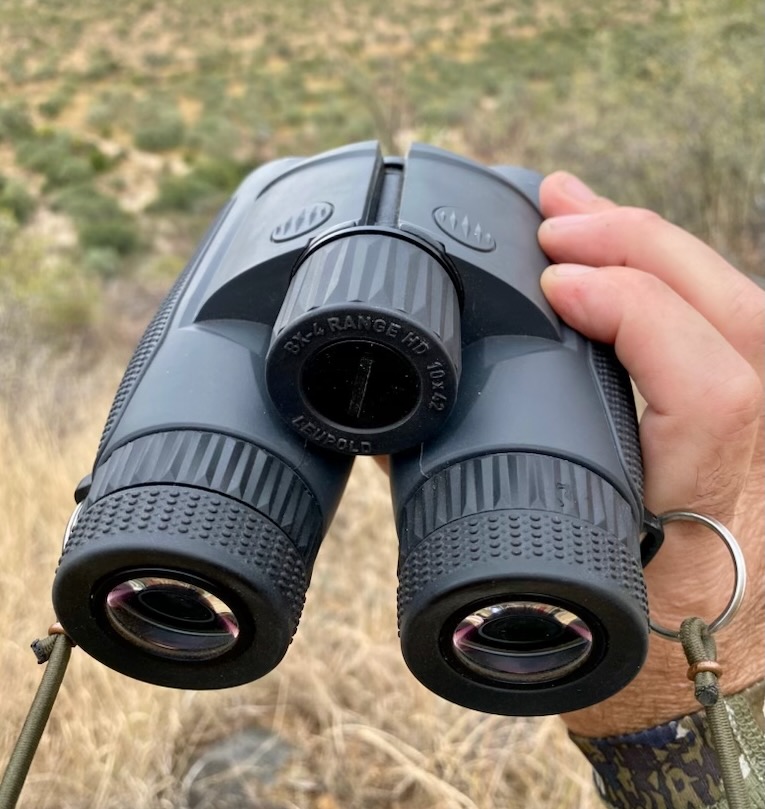
The result is that the BX-4 Range is a true hunters’ laser ranging binocular. While the recent trend is to connect a LRF binocular to a mobile app and customize aiming solutions based on precise ballistic profiles, the Leupold unit uses quick field deployment over lagging wireless connection to one or more satellite-enabled devices.
The result is that this is a true hunters’ device. I used a prototype of the Leupold during a trophy mule deer hunt in Sonora, Mexico, in trip-wire situations that required more close-range glassing than far-distant rangefinding. My experience showed the value of the binocular half of a rangefinding binocular’s attributes. You need good glass, glare-cutting coatings, a bright and simple display, and a wide field of view for most hunting situations. When I needed to know the precise range to a distant buck, the Leupold BX-4 Range quickly and simply provided the distance and a cartridge-specific aiming solution.
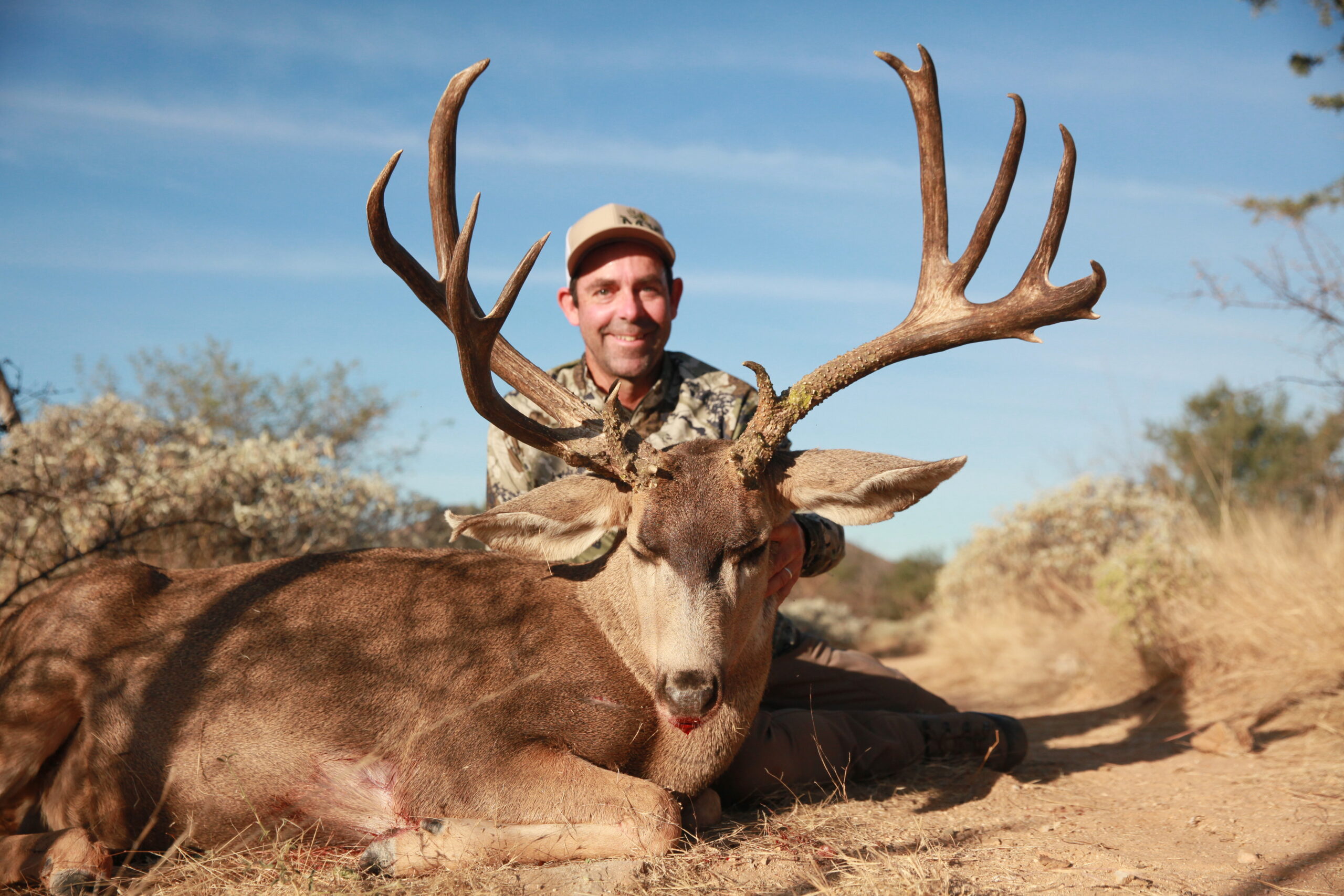
The unit will undoubtedly leave some shooters cold. If you want to port your own environmental data and custom ballistic curves into the rangefinding bino, you’re outta luck. Same if you want a 5-mile rangefinder with fancy target modes. Pure optics users may also be underwhelmed. Because the rangefinder uses an additional lens element for the rangefinding beam-splitter, and because coatings are tuned to make the red OLED display pop, the optics aren’t quite as clear and crisp as a binocular without the electronics.
But what the BX-4 Range brings to hunters is a field-worthy rangefinder with very good optics that combines real-world ranging with real-world viewing for a very fair price of around $1,600, given Leupold’s excellent warranty and customer service. That makes it a very serious and useful hunting companion.
Read Next: Best Rangefinders for Hunting
Best for Precision Shooting: Bushnell Match Pro ED 15×56
Score Card
- Optical Performance: Good
- Mechanical Performance: Very Good
- Design: Very Good
- Price/Value: Very Good
Key Features
- Double-hinge, open-barrel design
- Optic contains MRAD Shot-Call reticle
- Reticle leveler capability
- Dual diopter controls
- Double tripod attachments
- Magnesium chassis
Pros
- Intended as range spotter device
- Built around premium ED glass
- Extremely tripod-mountable
- Ships with “BridgeSet” interpupillary distance device
- Excellent price for premium 15-power binocular
Cons
- Reticle makes this a niche product
- At over 3 pounds, fairly heavy and bulky
New for 2023, Bushnell’s Match Pro ED binocular is designed for competitive shooters, but it has plenty of attributes for long-distance Western hunting situations. The heart of the binocular, built around Bushnell’s excellent Forge 15×56 binocular, is a MRAD-based reticle that features a 2/10 style grid, meaning that shooters have references for every .5 MRAD inside the central grid.
Sure, you can use the reticle to call shots on a long-distance steel range, but the system has abundant feedback for guides and companions of elk, mule deer, and bighorn sheep hunters who routinely take longish shots. Used as a spotter, the Bushnell can help hunters make pinpoint follow-up shots by using the same references that shooters have in their riflescopes’ reticles.
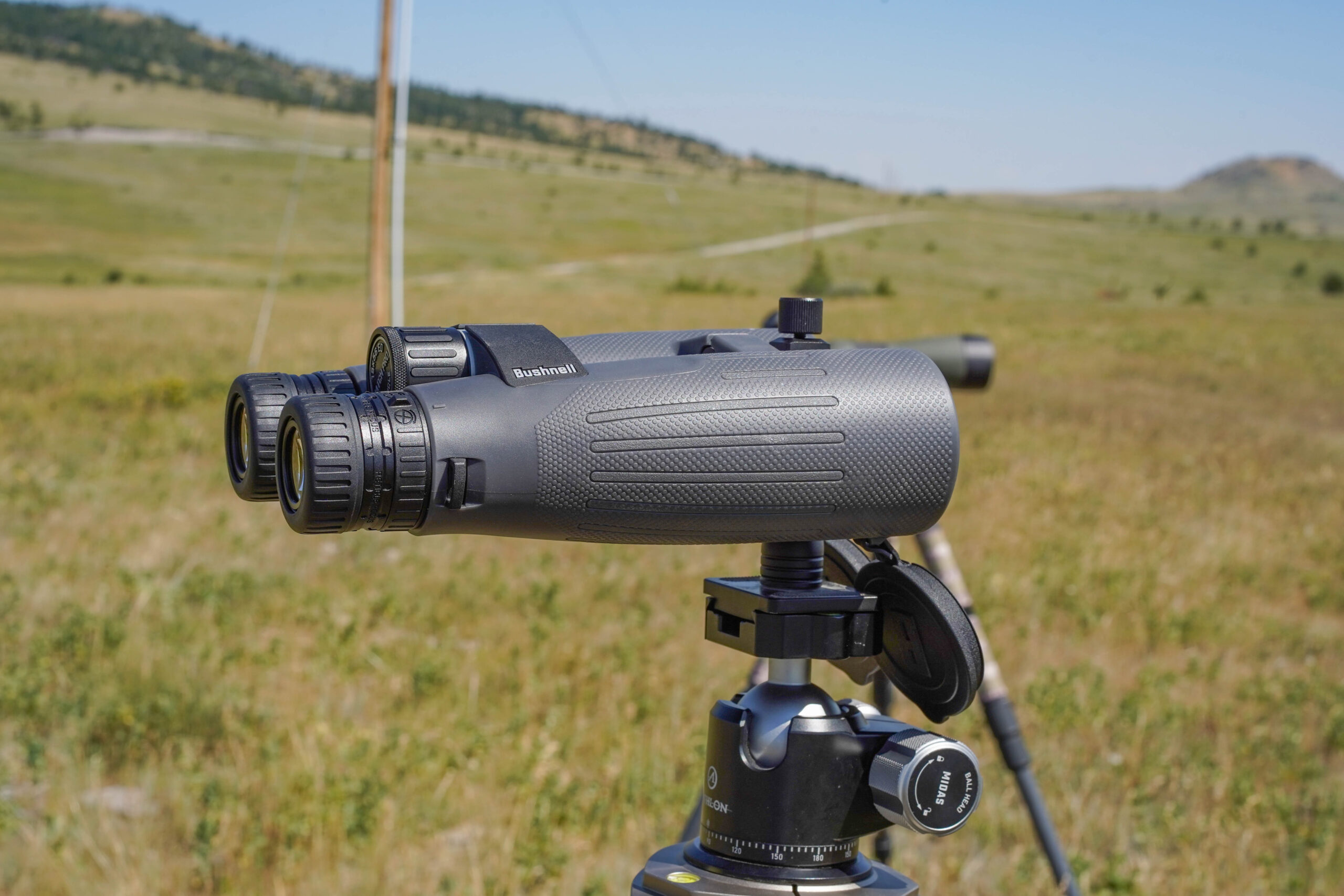
Outside of its ranging grid, the reticle features 20 MIL of elevation references and 20 MIL of windage references on either side of the central grid. It also has .1-MIL mover and ranging references.
The Shot-Call reticle is certainly distracting for pure wildlife viewers, but Bushnell boosts the value proposition of the Match Pro ED by bringing excellent glass, coatings, and adjustments to the platform.
The reticle leveling system is genius, keeping the reticle level with whatever horizon users are glassing and for any interpupillary distance (that’s the distance between the center of our two pupils). The display focus knobs keep both the reticle and the image independently sharp. And lastly, the device is tripod-mountable on either the inner or outer hinge, giving users plenty of stabilization options.
Will guides and companions of long-distance hunters gravitate to the Match Pro? I hope so, but even if hunters don’t appreciate the added value of the integrated reticle, this is bound to be a critical companion to PRS shooters who prefer the wide angle and binocular performance of a both-eyes-open optic over a spotting scope. At about $700, there’s a ton of value inside this magnum binocular.
Read Next: Best Long Range Rifles
Best Ballistic Rangefinding Binocular: Leica Geovid Pro 42
Score Card
- Optical Performance: Very Good
- Mechanical Performance: Excellent
- Design: Excellent
- Price/Value: Good
Key Features
- Premium glass
- Laser ranging to 3,000 yards
- Pre-installed Applied Ballistic Ultralight software
- Double-hinge, open-bridge design
- On-board environmental sensors
- Rugged magnesium chassis
- Also available in 8×32, 10×32, 8×42, and 8×56 versions
Pros
- GPS-enabled tracking aid
- Wide field of view
- Custom ballistic profiles available through Bluetooth
- Connects to mobile app and Kestrel devices
Cons
- High and long learning curve
- At about $3,300, very expensive
- At over 2 pounds, it’s a unit
If Leupold’s new BX-4 Range is the perfect out-of-the-box rangefinding binocular for hunters, then the Leica Geovid Pro 42 is a unit that rewards studious attention to detail. There is so much under the hood of this European high-performance optic that it can take an entire hunting season to unlock its capabilities.
Want a very precise laser rangefinder that offers aiming prescriptions for your specific custom rifle load? The Geovid Pro 42 will deliver it by connecting to Leica’s excellent Leica Ballistics App 2.0. Or maybe you want best-in-class glass to make a low-light shot? Leica’s very good glass and optical design delivers. Or maybe you want to know where that animal was when you took your shot? The GPS-enabled mapping service pairs with your mobile phone to show you precisely where to begin tracking.
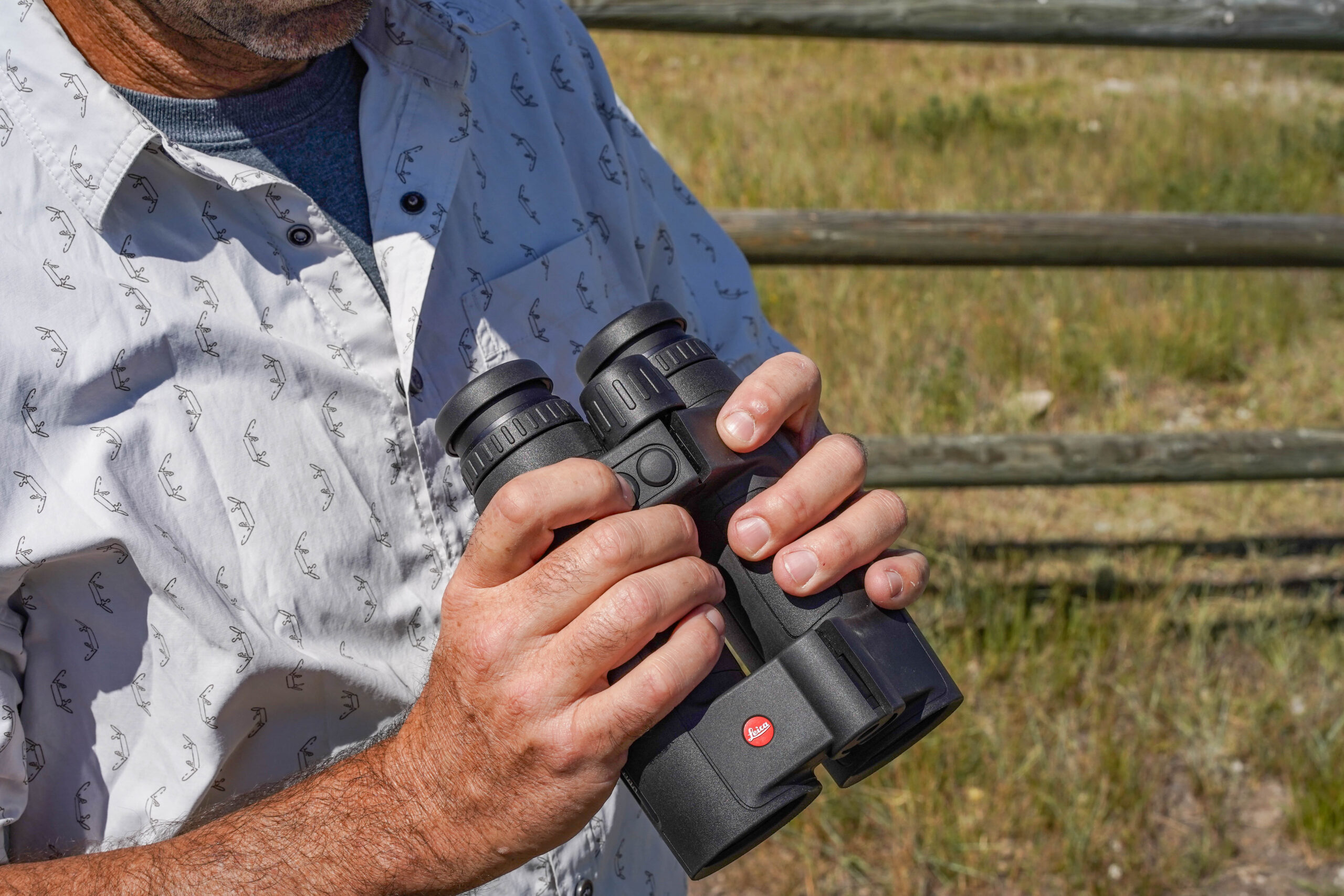
The unit also pairs with Kestrel devices to get real-time wind direction and speed updates, and the on-board software calculates windage holds based on that information. The software also calculates angle of the shot, air pressure, temperature, and altitude, essentially giving you superpowers for a lethal shot.
The 42mm version of the Geovid Pro is new for this year; the inaugural version of the platform debuted in a 10×32 configuration last year. The 10×42 is pretty boxy and hefty, tipping the scales at a little over 2 pounds. For most hunting situations where I might need all the laser rangefinding capabilities the platform delivers, such as extreme backcountry hunts in rigorous terrain, I’d probably opt for the trimmer 10×32.
Best Premium Binocular: Swarovski NL Pure
Score Card
- Optical Performance: Excellent
- Mechanical Performance: Very Good
- Design: Excellent
- Price/Value: Good
Key Features
- Hand-fitting design
- Fluorite glass
- Magnesium-alloy chassis
- Short closed-bridge design
- Field-flattener lens system
- Wide field of view
Pros
- Curved barrels hug hands, minimizing shake
- Extremely positive focus wheel
- Tapered three-position eyecups
- Long eye relief
Cons
- At about $3,500, wildly expensive
Swarovski’s NL Pure might well be the perfect binocular. The hourglass curves of its shapely barrels grip your hands, creating a rock-solid support for glassing with even the 12-power model. The field-flattener lenses create a picture-window view of the world. And the immense field of view—among the widest in the business—gives you a lot to look at.
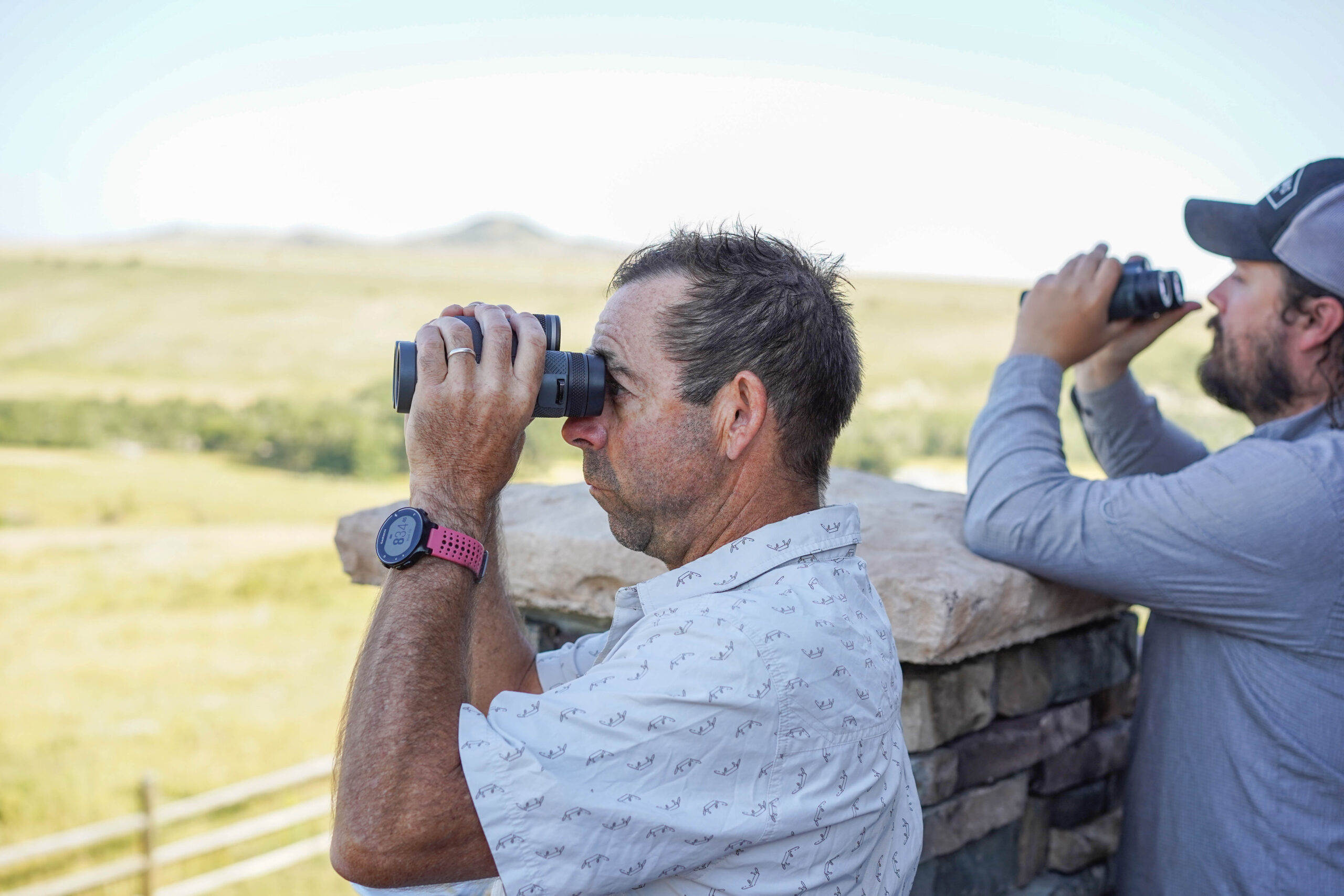
As might be expected, Swarovski brings its best class of glass—a fluorite recipe that tames aberrant light and intensifies colors and depth—to the NL Pure. But if the stunning image gets your attention, the mannerly controls keep you glassing. The oversized focus wheel turns with precision, and the eyecups fit most brows comfortably. In short, it’s a joy to use for extended periods of time, which is one of the best attributes of a premium hunting binocular.
But all that performance comes at a price, and in the case of the NL Pure, that price is well north of $3,000. That stratospheric cost puts it out of reach of most mortal hunters, and it also serves to make it a little too precious to use in hard-core hunting situations, where optics are in danger of getting scratched, dented, and abused. For that reason alone, we can’t quite give this the Best Hunting Binocular, despite its abundant best-of attributes.
Nikon Monarch M5 8×42
Score Card
- Optical Performance: Good
- Mechanical Performance: Good
- Design: Very Good
- Price/Value: Very Good
Key Features
- Closed-bridge, roof prism design
- Right-barrel diopter control
- Fiberglass-reinforced polycarbonate resin body
- Premium glass and coatings
- Tripod adaptable
- Non-transferable lifetime warranty
Pros
- Extra-low-dispersion glass in objective lenses
- 8.2-foot close focus
- Wide field of view
- Very light weight (22.2 ounces)
- Appealing price, under $150
Cons
- Spongy focus
- Poor low-light performance
Nikon seems to have an inexhaustible supply of appealing price-point binoculars. We tested a very capable Prostaff in this test, and Nikon has been a stalwart of our good-optic-for-the-price binocular for at least 15 years. The Monarch M5 continues that trend. It brings very good glass for the price, and the coatings and controls are of a quality you’d expect from a binocular that costs several times the Monarch M5’s under $150 price point.
Introduced this year, the Monarch M5 posted one of the best resolution scores in our budget bino test, and testers noted a pleasing image free from distracting flaring and distortion, again an exception for a budget bino. The Nikon disappointed in the low-light test, but its performance may be explained by its 8-power configuration. It’s worth noting that the M5 is also available in 10×42 and 12×42 versions.
In summation, the Nikon Monarch M5 is a solid, fairly priced binocular that would make an excellent first optic for a new hunter or outdoor person, or a reliable backup optic for a pickup or side-by-side.
How to Choose a Hunting Binocular
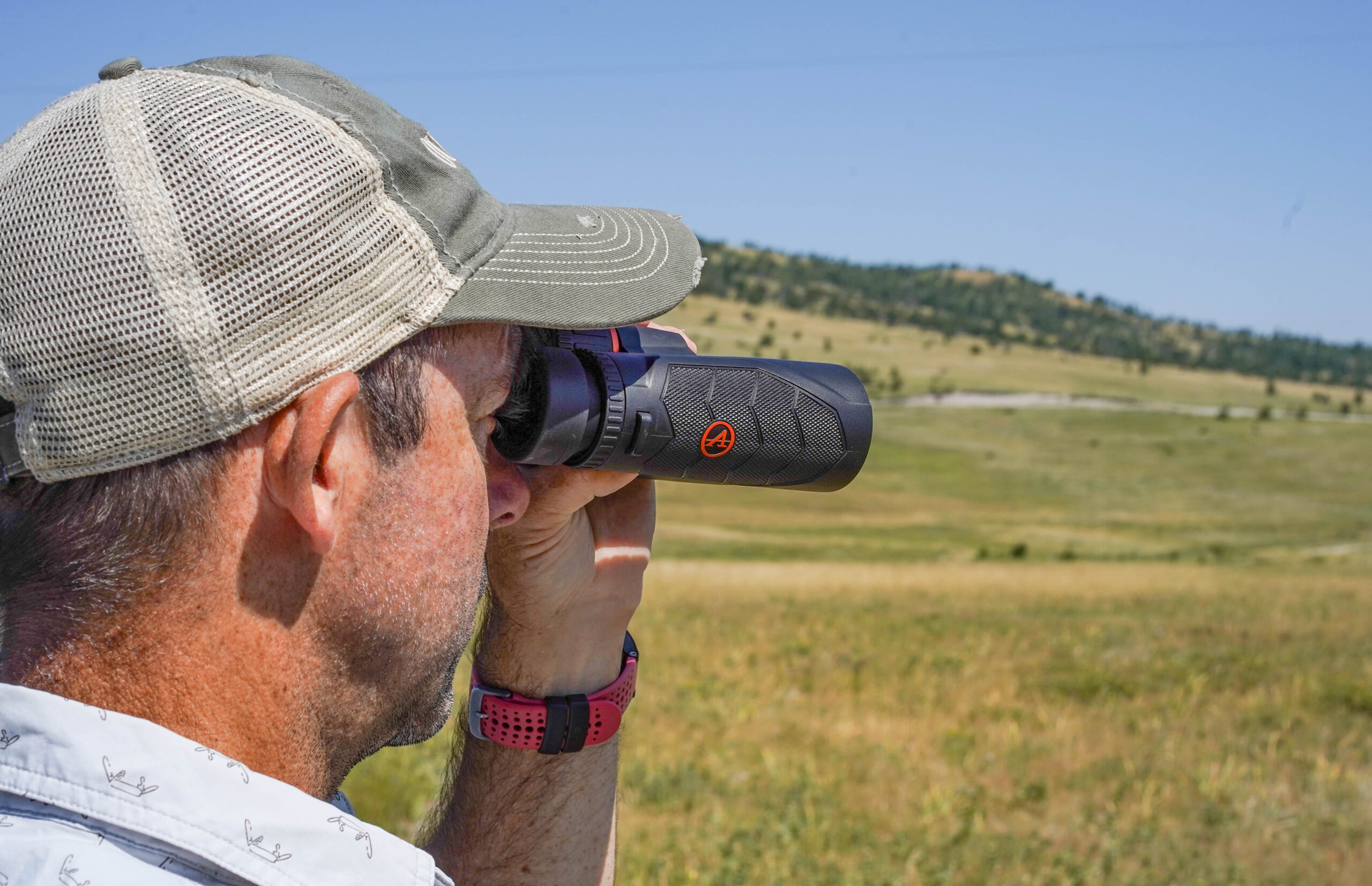
There is no shortage of binoculars that can serve as adequate hunting binoculars, so what qualities elevate an optic into our ranks as the best in the business? The first is consistent performance. We removed from consideration those models with fussy focus knobs and eyecups that slip or crack. But the biggest factor for us is glassing comfort. Does the binocular fit our hands and face? Is the glass clear and bright enough that we want to keep using it? The more pleasing the glassing experience, the more you’ll glass. The more you glass, the more game you’ll see and the more successful your hunt. Most of that credit goes to a good binocular.
Of course, there are plenty of other attributes to consider. How durable is the binocular? We’re not proud to report that we abuse our optics in the course of a season, as we hunt hard over uneven terrain. The best hunting binos have excellent armor and rugged controls that work in below-zero temperatures, in rain, and when we’re wearing gloves.
Lastly, we picked a variety of magnifications, chassis sizes, and capabilities because every hunt is different, and you want to pick the model that matches the way you hunt. If you’re hunting a tight woodlot in Connecticut, you don’t need a big 12-power binocular with a laser rangefinder. But if you’re hunting Dall sheep on an open Alaskan mountain ridge, you want as much optical and laser rangefinding horsepower as you can get to make positive identification of your target and then an anchoring shot.
It’s been said that you want to pick the most expensive optic that you can afford, because price and performance are directly proportional when it comes to binoculars. And confirm the warranty and customer-service reputation of the brands, too. If you hunt as hard as we do, there’s every chance that at some point or another, you’ll need to activate the warranty.
FAQs
The short answer is yes. For safety, because binoculars enable you to see distant objects without pointing your gun at them and using your riflescope as a telescope is never a good idea. For ethics, to make sure of your target before shooting at it. For efficiency, because binoculars shrink distance and allow you to assess far objects without walking all the way to them. And for success, because binoculars help you see distant animals in the first and last hours of the day, when they’re most likely to be moving.
Every binocular has two numbers. The first is the magnification, or the amount of times the image is enlarged. The second is the size of the objective lens, in millimeters. The objective lens is the larger lens that points toward your target when you look through a binocular, and the larger the objective lens, the more light and detail enter the eye. Using this formula, an 8×32 binocular has 8-times magnification (or “power”) and a 32mm objective lens.
If you’re still wondering, what do numbers on binoculars mean, here are more tips. Typically, the larger the numbers, the greater the optical performance, but also the physical size of the binocular. A 6×24 binocular is small enough to fit in a shirt pocket. A 15×56, on the other hand, is so large it’s hard to hold in your hand. Hunters want a binocular that is powerful enough to see distant objects but small enough to be portable. The sweet spot for most hunters is an 8- or 10-power behind a 32 to 42mm lens. So look for models with these numbers: 8×32, 8×42, 10×42, or for light-gathering ability, 10×50.
You can spend as little as $100 or as much as $4,000 for a hunting binocular. Generally, the more money you spend, the better the binocular, but because there’s a limit to your budget, you probably want to buy the best binocular for your money. The good news is there are lots of choices in the $400-$600 range. That’s still a lot of money, but here are three things to consider:
• Warranty – Does your brand have your back? Many optics companies offer fully transferrable lifetime warranties for binoculars. That means it’s covered for repair or replacement whether you bought the optic yourself or bought it second-hand.
• Accessories – Many brands include zippered cases or harnesses with their binoculars, a savings of around $50.
• Performance – If you spend $500 or more for an optic, you want to be sure it’s going to deliver. Look for models that have high light transmission (90 percent or higher), good customer reviews, and are built for battle, with double hinges, durable armor, and controls (focus wheels and eyecups) that move with precision and authority.
Final Thoughts on the Best Hunting Binoculars
This is admittedly a partial list, but it’s based on both empirical performance of hunting binoculars in the course of our optics testing, and it’s based on our own experience with several of these models in the field. Consider it a good starting point for your own search. The main point: don’t check out one binocular and consider your work done. You’ll want to put several contenders in a head-to-head test and compare and contrast their performance against each other. If you’re still not satisfied, then keep pairing up contenders until you find one that fits your style, particular optical prescription and physical dimensions, and your budget.
- Best Overall: Zeiss SFL 8×40
- Best Value: Vortex Triumph HD 10×42
- Best for Bowhunting: Maven B.7 8×24
- Best for Western Hunting: Vortex Razor HD 10×42
- Best Rangefinding Binocular: Leupold BX-4 Range 10×42
- Best for Precision Shooting: Bushnell Match Pro ED 15×56
- Best Ballistic Rangefinding Binocular: Leica Geovid Pro 42
- Best Premium Binocular: Swarovski NL Pure
- Burris Droptine HD
- Nikon Monarch M5 8×42

